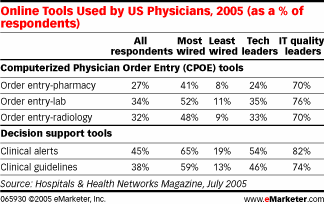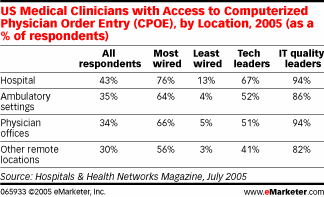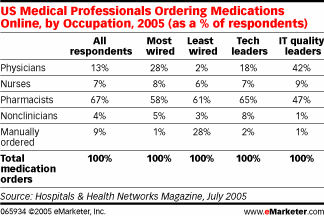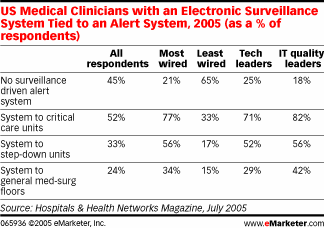 |
|
|
Hospitals that have invested significantly in health information technology have lower mortality rates than other hospitals. "There are three key differences in how hospitals apply and use information technology to improve care," said Alden Solovy, executive editor of Hospitals & Health Networks, the journal of the American Hospital Association. "The 'Most Wired' use a wider array of IT tools to address quality and safety, they have a significantly larger percentage of physicians who enter orders themselves and they conduct a larger percentage of clinical activities via information technology." And they are safer environments for patients. According to Hospitals & Health Networks' annual "100 Most Wired" survey, the top wired hospitals have, on average, risk-adjusted mortality rates that are 7.2% lower than other hospitals. The relationship between improved outcomes and information technology has been previously documented in both academic and practitioner research, but those studies usually dealt with specific projects and targeted safety improvements. According to H&HN, this is the first analysis showing that hospitals with broad use of information technology across a variety of projects also have better outcomes. H&HN called the differences between "Most Wired" and "Least Wired" hospitals "staggering." The analysis does not establish an explicit causal relationship between IT and outcomes. But it points hospitals and health care organizations in a positive direction. "The association is strongly suggestive, not causal, but it's an important piece of the research," said Carolyn Clancy, M.D., the director of the Agency for Healthcare Research and Quality, according to the article. Behind the mortality analysis, the "2005 Most Wired" data found three significant differences in how hospitals apply and use information technology to improve care:
Among the Most Wired, 41% said they have achieved full adoption of pharmaceutical order entry by physicians, compared with the 8% adoption rate among the Least Wired. The survey also broke out results for "IT Quality Leaders," the 50 hospitals that scored highest on the survey's safety and quality section, and "Tech Leaders," which are the hospitals on the 100 Most Wired list that are not among the IT Quality Leaders.
The availability of order entry is also important. The Most Wired hospitals provide clinicians with access to CPOE functions from more locations — 30% provide access from physician offices, ambulatory settings or other remote locations, compared with only 5% among the Least Wired.
The survey also found that the Most Wired were more proficient at medication delivery. Among the 100 Most Wired, 28% of medication orders are entered electronically by physicians. Among the Least Wired, less than 2% of medication orders are entered electronically by doctors.
The use of electronic alerts by physicians, nurses and pharmacists among the Most Wired hospitals was high, with full adoption rates ranging 48% to 100%. Full adoption rates in the Least Wired group ranged from zero to 67%, with duplicate order, drug-drug interaction, dose checking and allergy alerts being the most common.
Technologically advanced hospitals have linked clinical alerting with electronic surveillance to monitor patient vital signs, lab test results and other clinical information in order to notify caregivers in advance of any deterioration in a patient's condition.
Nevertheless, technology is not the end-all solution. As the article states: "Most chief information officers and chief medical officers say that, to be effective, adoption of information technology must be combined with clinical process improvements and a culture of safety." "What we know from the studies we're supporting is that technology is only part of the drive to improve quality," Dr. Clancy said. "It clearly has to be linked with process improvement."
|
|||||





